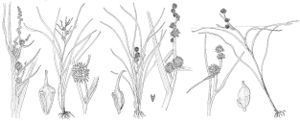Sparganiaceae
Herbs, perennial, aquatic or paludal, emergent or leaves and inflorescence floating, rhizomatous, caulescent in flower, glabrous. Leaves basal and cauline, reduced to persistent foliaceous bracts on flowering stem, 2-ranked, erect or floating; sheaths open, sometimes inflated, especially on bracts, margins clear to scarious, not auriculate; blades flat to keeled, linear, apex obtuse to rounded or retuse, aerenchyma present. Inflorescences 1, terminal, erect and emergent or peduncle floating, usually not exceeding basal leaves; heads globose, sessile or peduncled, congested to remote along an often zigzag simple or branched rachis; staminate heads deciduous but rachis often persistent, distal to pistillate heads, sessile, proximal ones often subtended by foliaceous bract; pistillate heads sessile or peduncled, axillary or supra-axillary (peduncle partly adnate to rachis) to bract, or not bracteate. Flowers unisexual, staminate and pistillate on same plants, numerous, crowded in unisexual (occasionally bisexual) heads, sessile to stipitate, often subtended by tepaloid bract, wind-pollinated; tepals mostly 3–6, free, translucent to opaque, white to green when fresh, club-shaped to spatulate, entire to notched or erose-tipped, with or without subapical thickened dark area. Staminate flowers sessile, white or whitish; stamens 2–8, much exceeding tepals, distinct or filaments basally connate; anthers basifixed, connective widened. Pistillate flowers hypogynous, sessile to stipitate; pistil 1, exceeding tepals, syncarpous, 1– or 2(–3)-carpellate (functional), (0–)1–2-carpellate (abortive); ovary 1–2(–3)-locular; ovule 1 per locule, pendent; style 1, usually elongating in fruit, forming beak, obsolete in 1 species; stigmas 1–2, white to greenish, linear to ovate or subcapitate; agamous flowers absent. Fruits achenelike drupes (often called achenes), obpyramidal with sides faceted and top truncate, to fusiform or ellipsoid with sides weakly or not faceted but tapering to beak, sometimes constricted at or near equator; dried exocarp persistent and spongy; endocarp hard; tepals persistent, attached at base except partly adnate to stipe in 1 species. Seeds: endosperm abundant, mealy; embryo linear, straight.
Distribution
Mostly in north temperate zone, some circumboreal, a few south to Mexico, New Zealand, and Australia.
Discussion
The flower -heads are of two or more highly condensed racemes (D. Müller-Doblies 1970; U. Müller-Doblies 1969). The staminate flowers are extremely crowded and difficult to differentiate. The drupes are crowded in globose head made burlike by the persistent styles (beaks) and stigmas.
All chromosome accounts published to 1985 are given by C. D. K. Cook and M. S. Nicholls (1986).
Sparganium is sometimes included in Typhaceae.
Genus Genera 1, species 14 (9 species in the flora).
